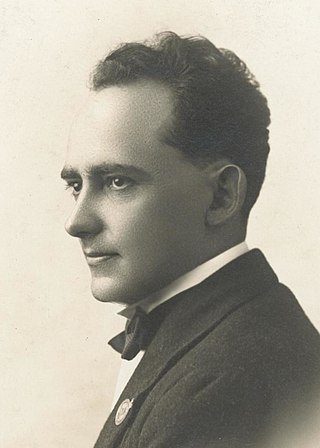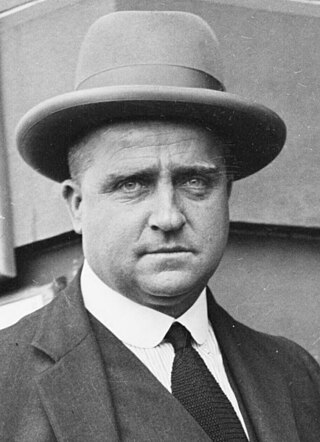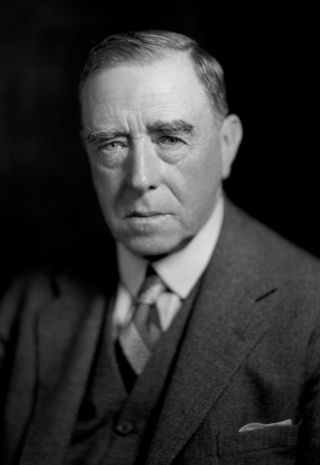
The United Australia Party (UAP) was an Australian political party that was founded in 1931 and dissolved in 1945. The party won four federal elections in that time, usually governing in coalition with the Country Party. It provided two prime ministers: Joseph Lyons (1932–1939) and Robert Menzies (1939–1941).

The Nationalist Party, also known as the National Party, was an Australian political party. It was formed in February 1917 from a merger between the Liberal Party and the National Labor Party, the latter formed by Prime Minister Billy Hughes and his supporters after the 1916 Labor Party split over World War I conscription. The Nationalist Party was established as a 'united' non-Labor opposition that had remained a political trend once the Labor party established itself in federal politics. The party was in government until electoral defeat in 1929. From that time it was the main opposition to the Labor Party until it merged with pro-Joseph Lyons Labor defectors to form the United Australia Party (UAP) in 1931. The party is a direct ancestor of the Liberal Party of Australia, the main centre-right party in Australia.

The Liberal–National Coalition, commonly known simply as the Coalition or the LNP, is an alliance of centre-right to right-wing political parties that forms one of the two major groupings in Australian federal politics. The two partners in the Coalition are the Liberal Party of Australia and the National Party of Australia. Its main opponent is the Australian Labor Party (ALP); the two forces are often regarded as operating in a two-party system. The Coalition was last in government from 2013 to 2022. The group is led by Peter Dutton, who succeeded Scott Morrison after the 2022 federal election.

The Australian Party was a political party founded and led by former Australian prime minister Billy Hughes after his expulsion from the Nationalist Party. The party was formed in 1929, and at its peak had four members of federal parliament. It was merged into the new United Australia Party in 1931, having never contested a federal election.

The 1917 Australian federal election was held in Australia on 5 May 1917. All 75 seats in the House of Representatives and 18 of the 36 seats in the Senate were up for election. The incumbent Nationalist Party, led by Prime Minister Billy Hughes, defeated the opposition Labor Party led by Frank Tudor in a landslide.

John Moore Chanter was an Australian politician, farmer and commission agent. He was a member of the Protectionist Party, as well as the Australian Labor Party and the Nationalist Party of Australia.

The 1934 Tasmanian state election was held on 9 June 1934 in the Australian state of Tasmania to elect 30 members of the Tasmanian House of Assembly. The election used the Hare-Clark proportional representation system — six members were elected from each of five electorates.

Edward Riley was an Australian politician. He was an Australian Labor Party member of the Australian House of Representatives for South Sydney from 1910 to 1931.

The All for Australia League (AFAL) was an Australian political movement during the Great Depression. It was founded in early 1931 and claimed to have amassed 130,000 members by June 1931. Right-wing and anti-establishment in nature, the league had the backing of a number of prominent businessmen and industrialists. It was critical both of the Labor Party and the right-wing Nationalist Party. It primarily operated in Sydney, but also had branches in country New South Wales and absorbed a similar organisation in Victoria. The league eventually chose to co-operate with the existing Nationalist organisation at the 1931 federal election, helping preselect candidates for the new United Australia Party (UAP). After the election victory the league was absorbed by the UAP's state organisation.
This is a list of members of the Western Australian Legislative Council from 22 May 1916 to 21 May 1918. The chamber had 30 seats made up of ten provinces each electing three members, on a system of rotation whereby one-third of the members would retire at each biennial election.

Lionel Thomas Courtenay was an Australian businessman and politician. Born in Sydney, he left school at a young age but became general manager of an engineering company. He was involved in local politics, sitting on Mascot Council, Mosman Council and Sydney City Council. In 1932, he was elected to the New South Wales Legislative Council as a member of the United Australia Party. He left the Council in 1934 to contest the Australian Senate as a UAP candidate for New South Wales, in which he was successful. However, he died on 11 July 1935, 11 days after he formally became a Senator, necessitating the appointment of Guy Arkins to replace him.

James Guy Dalley Arkins was an Australian politician.
This is a list of the members of the Australian House of Representatives in the 12th Australian Parliament, which was elected at the 1929 election on 12 October 1929. The incumbent Nationalist Party of Australia led by Prime Minister of Australia Stanley Bruce in power since 1923 with coalition partner the Country Party led by Earle Page was defeated by the opposition Australian Labor Party led by James Scullin. Labor won with its then largest-ever majority in the federal parliament. However major divisions within the Labor over policy responses to the Great Depression, and the subsequent creation of the United Australia Party led to thirty parliamentarians changing their party affiliation in 1931.
This article provides information on candidates who stood for the 1931 Australian federal election. The election was held on 19 December 1931.
This is a list of members of the Australian Senate from 1929 to 1932. Half of its members were elected at the 14 November 1925 election and had terms starting on 1 July 1926 and finishing on 30 June 1932; the other half were elected at the 17 November 1928 election and had terms starting on 1 July 1929 and finishing on 30 June 1935. The process for filling casual vacancies was complex. While senators were elected for a six-year term, people appointed to a casual vacancy only held office until the earlier of the next election for the House of Representatives or the Senate.

Elections were held in the state of Western Australia on 15 February 1936 to elect all 50 members to the Legislative Assembly. The Labor Party, led by Premier Philip Collier, won a second term in office against the Country and Nationalist parties, led by Opposition Leader Charles Latham and Norbert Keenan respectively.
Members of the New South Wales Legislative Assembly who served in the 29th parliament held their seats from 1930 to 1932. They were elected at the 1930 state election, and at by-elections. The Nationalist Party was replaced by the United Australia Party in 1931. The Speaker was Frank Burke.

The 1932 New South Wales state election was held on 11 June 1932. This election was for all of the 90 seats in the 30th New South Wales Legislative Assembly and it was conducted in single member constituencies with compulsory preferential voting. It was a landslide victory for the UAP/Country Party coalition of Bertram Stevens, which had a majority of 42 in the Assembly.
This is a list of members of the Victorian Legislative Assembly from 1929 to 1932, as elected at the 1929 state election.

The 1932 Victorian state election was held in the Australian state of Victoria on Saturday 14 May 1932 to elect 44 of the 65 members of the state's Legislative Assembly. The other 21 seats were uncontested.















